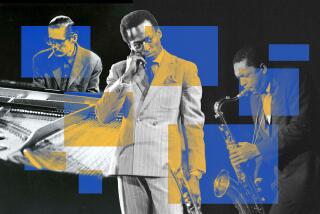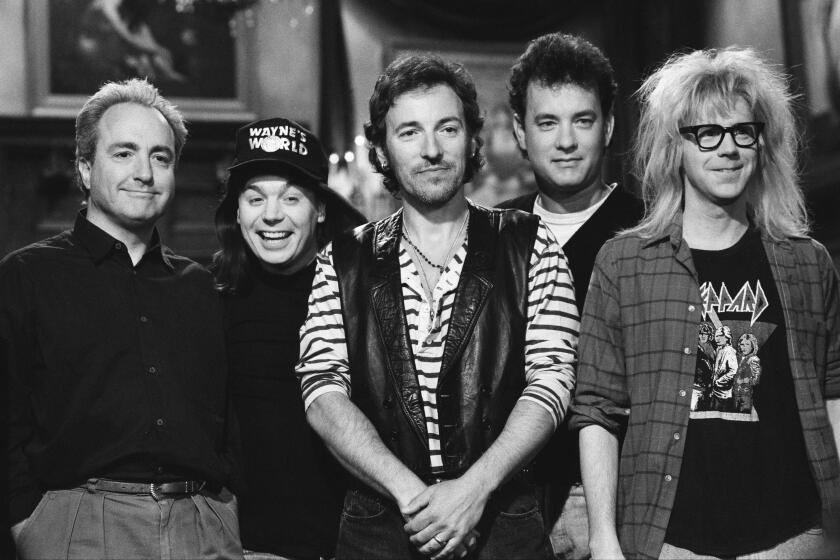Schuller: A Man Who Lives in Harmony
- Share via
Gunther Schuller may well be the ultimate Renaissance man of 20th-Century music.
His brilliant mind knows no barriers. During the last 40 years, his overlapping activities have found him playing French horn in the Metropolitan Opera and on a record date with Miles Davis; writing many works in the area of Western art music; composing and lecturing about “third stream music,” a term he coined in 1957 to denote the combining of jazz and so-called classical elements (a close associate was John Lewis of the Modern Jazz Quartet, who recorded several of his words); serving for 10 years as president of the New England Conservatory; composing and conducting for his 16-piece ragtime orchestra; and writing the most comprehensive and valuable series of textbooks ever to deal with jazz from a scholarly technical viewpoint.
Recently, after he visited Los Angeles to conduct the ragtime ensemble in a concert at Pepperdine University, Schuller’s relaxed mood belied his staggering schedule.
“It’s amazing,” he said, “how this music holds up for us. I can come into a ragtime concert feeling miserable, it’s been a lousy day, everything’s gone wrong, yet after the first four bars of ‘Maple Leaf Rag’ I’m flying! We do about 30 to 40 concerts a year, using some of the arrangements I’ve done, a lot of the Jelly Roll Morton things, and we have fun.”
Ragtime represents a minor facet of his multiple images. “The main thing,” he pointed out, “is that I’ve been very active as a composer and conductor. To give you an idea of how busy I am, right now I have 18 commissions, and I’m working on three of them more or less simultaneously. All of them have deadlines; one may be due next week, others in two or three years.”
The commissions are for symphony orchestras, string quartets, chamber ensembles, and as soon as one work is finished, Schuller accepts an assignment for another, so that his schedule for “serious” music is always full. The word “serious” has to be put into quotes, since jazz has long been a no less serious subject for Schuller.
Conducting is another time-consuming factor. “Lots of European conducting; lots of guest conducting--and that can take a week, because you’ve got maybe two or three concerts, and four rehearsals, so there goes the week. But I love doing that. Since I gave up the French horn 25 years, conducting has been my main performance activity.”
Just 20 years ago, Schuller’s seminal book, “Early Jazz: Its Roots and Musical Development” (Oxford), traced the music from its origins through the Depression years. Newly published, also by Oxford, is “The Swing Era,” an astonishingly detailed work covering the period from 1930-1945. Starting with a 50-page examination of Benny Goodman, it proceeds to a brilliant analysis of Duke Ellington (110 pages), Louis Armstrong, Jimmie Lunceford and Count Basie. After devoting 160 pages to 17 other great black bands, Schuller turns to the “great soloists” (a dozen instrumentalists and Billie Holiday), then spends 138 pages on the best known white bands, concluding with chapters on the “territory bands,” the small groups, and sounds to come.
Aside from its enormous size, Schuller’s 900 plus pages include no less than 530 musical illustrations, based on recorded examples of solos or arrangements. This, in fact, is not a book you just read; preferably you sit at the piano and play it, with a CD or LP player at your side.
In light of the time involved even in reading “The Swing Era,” one wonders how the author found time to write and assemble it.
“Well, it was slow and difficult. The first chapter I wrote, around 1970, was the one on Ellington. Then I realized that a book like this ought to start with Goodman, so I wrote his chapter.
“The fact is, I just struggled. There was a period of two or three years when I didn’t write a word or listen to a single record because I was busy with the Conservatory--in fact, that was one of the reasons I left there in 1977. I knew if I stayed I could never finish this book.”
Acquiring and listening to the records--some on ancient 78s or long cut-out albums--was a huge task in itself, for which Schuller thanks one of his two sons. “I engaged my son George for this job because he has an encyclopedic mind. He was in charge of amassing this tremendous record collection. We had to beg, borrow, buy, steal--it was lucky that at least in the past few years we’ve had this flood of reissues to draw on.”
The question arises: how can this book be meaningful to anyone unable to read music?
“Well, people can get a general idea of the overall shape of a line; they can feel the general essence of what I mean. But there is really no choice for me in a book that’s so essentially based on the music; that’s the approach we have in the classical literature, whether it’s about Beethoven or Schoenberg. The only difference is that with jazz you have to transcribe it. I do worry about that a bit, the state of musical illiteracy being what it is.”
On the other hand, musical literacy must have reached a reasonable level, since Schuller has two thriving publishing companies. “My music companies are idealistic, non-commercial ventures. I put out music that might not otherwise get published; contemporary stuff, also a fair amount of jazz, including Jimmy Giuffre, Charles Mingus, George Russell, Ran Blake and Johnny Carisi, and our own editions of ragtime by Eubie Blake, Scott Joplin and Joseph Lamb. I have 98 composers in my catalogue, and I put out beautiful engraved editions.
“Along with this I have a record company, GM Records. The most famous thing I’ve put out so far is a recording by (saxophonist) Eric Dolphy of some things he and I did in a concert when we toured in the early 1960s. It’s an interesting mix of jazz and classical.”
The same comment might be made regarding Schuller’s own career. In any given year, he may be found finishing up several major orchestral commissions, working on a book or article, controlling the publishing and record companies, and concertizing with his ragtime band.
“Somehow it all gets done,” he said. “And then you throw in the lectures and the composer residencies. You could say it’s a full life.”
More to Read
The biggest entertainment stories
Get our big stories about Hollywood, film, television, music, arts, culture and more right in your inbox as soon as they publish.
You may occasionally receive promotional content from the Los Angeles Times.










